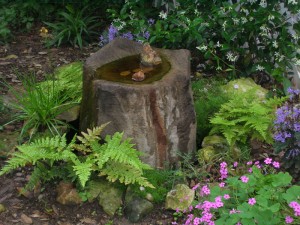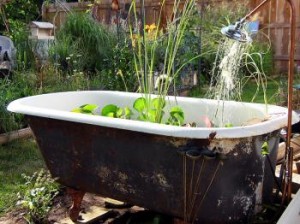





Although container water features are quite small, they still need to be carefully planned if they are to be a practical and visual success. Their position within a garden is also important.
 Although the water feature itself may be tastefully planted, it is crucial that, as an element of the garden landscape, it fits into the overall design. This is particularly relevant where the container garden water feature is not easily movable, or is sunk into the ground.
Although the water feature itself may be tastefully planted, it is crucial that, as an element of the garden landscape, it fits into the overall design. This is particularly relevant where the container garden water feature is not easily movable, or is sunk into the ground.
The first thing to realise is that a container water garden feature is rarely self-sustaining, and that it is almost impossible to create a natural balance within such a feature. This means that when planting it you have to keep in mind that it will need to be periodically emptied. Therefore, both the position of the feature itself and the planting arrangements must be carefully considered.
Irrespective of the type of garden water feature, it should be situated in full sun, since most plants require sunlight to thrive. There is little to be gained by positioning water out of the sun — a dancing fountain in the shade does not have much visual impact.
Otherwise, the way in which you introduce water into your garden is very much a matter of personal taste.
Small pools and tubs are at their most attractive when viewed at close quarters, so it makes sense to site them close to areas where people sit and relax. Where moving water is involved, especially a fountain, make sure that the site is sheltered. Wind and fitful breezes cause the spray from a fountain to blow around, making it uncomfortable for anyone to sit or garden in the vicinity. It also creates more work, since the reservoir has to be constantly refilled to prevent the pump from running dry and overheating.
A rarely considered advantage of container water gardening is that it provides an opportunity for plant enthusiasts to grow unusual varieties that would not flourish in the rest of the garden. A watertight window box solidly planted with bog garden plants and watered heavily produces a spectacle of fascinating and colourful plants that could otherwise only be enjoyed in a custom-made bog garden.
Most gardeners prefer outdoor water features, since they are much easier to control and manage, especially where plants are involved.
With indoor water features and in warmer climates, tropical plants can be used. Choose varieties that are small and undemanding, as many tropical plants are tall and occupy a lot of space.
 When arranging the planting within a container, remember that water is important for its own sake. Do not plant so that the water is entirely lost to view, unless you intend to make a bog garden.
When arranging the planting within a container, remember that water is important for its own sake. Do not plant so that the water is entirely lost to view, unless you intend to make a bog garden.
Where plants are meant to be an integral part of a feature, they must be taken into account from the outset. In order to thrive, most of them must be placed in a sunny position. While some of the submerged aquatics can exist with their roots in gravel, all others, except those that float on the surface, must have their roots in aquatic compost. Some will flourish in a modest amount of compost, but you must treat others in the same way you would if you planned to grow them in a conventional pond: provide them with fair-sized planting containers and adequate amounts of compost.
If you find it difficult to plant up the part of the feature that contains water, consider the possibility of peripheral planting. It is often simpler to create the water part of your design as you want it and then place this in another watertight container in which plants can be grown in an accompanying role. Such plantings often produce a more harmonious, less contrived effect.
While everyone enjoys having fish in a water feature, great caution should be exercised when introducing them into sinks and pots. Fish require a generous water surface to provide them with sufficient oxygen and a reasonable depth of water in order to keep cool. Only large commercial barrels or do-it-yourself constructions are likely to be deep enough and, more importantly, have sufficient water surface area to accommodate fish safely. They can be kept where there is continuous turbulent water, since this provides a ready supply of oxygen, but it is hardly fair to keep them in endless frothing and foaming water.
Unplanted garden water features, which provide the soothing sound and visual pleasure of water, are often a good idea and are particularly easy to care for, as they require almost no maintenance. Where the water is the main element of the feature and plants do not figure, take into consideration stillness, reflection, movement, colour and sound. Water can bring all these qualities to a garden if you plan the feature thoughtfully. The manner in which you achieve this can be almost as varied as the features themselves, ranging from drips and gushes to trickles and sprays. Moving water can differ widely in its effect, not only with regard to sound but also to light: both overcast skies and contrasting bright sunshine can play an important part.
So, when planning and designing your garden water feature, take all of these aspects into account.
Copyright © www.100flowers.win Botanic Garden All Rights Reserved